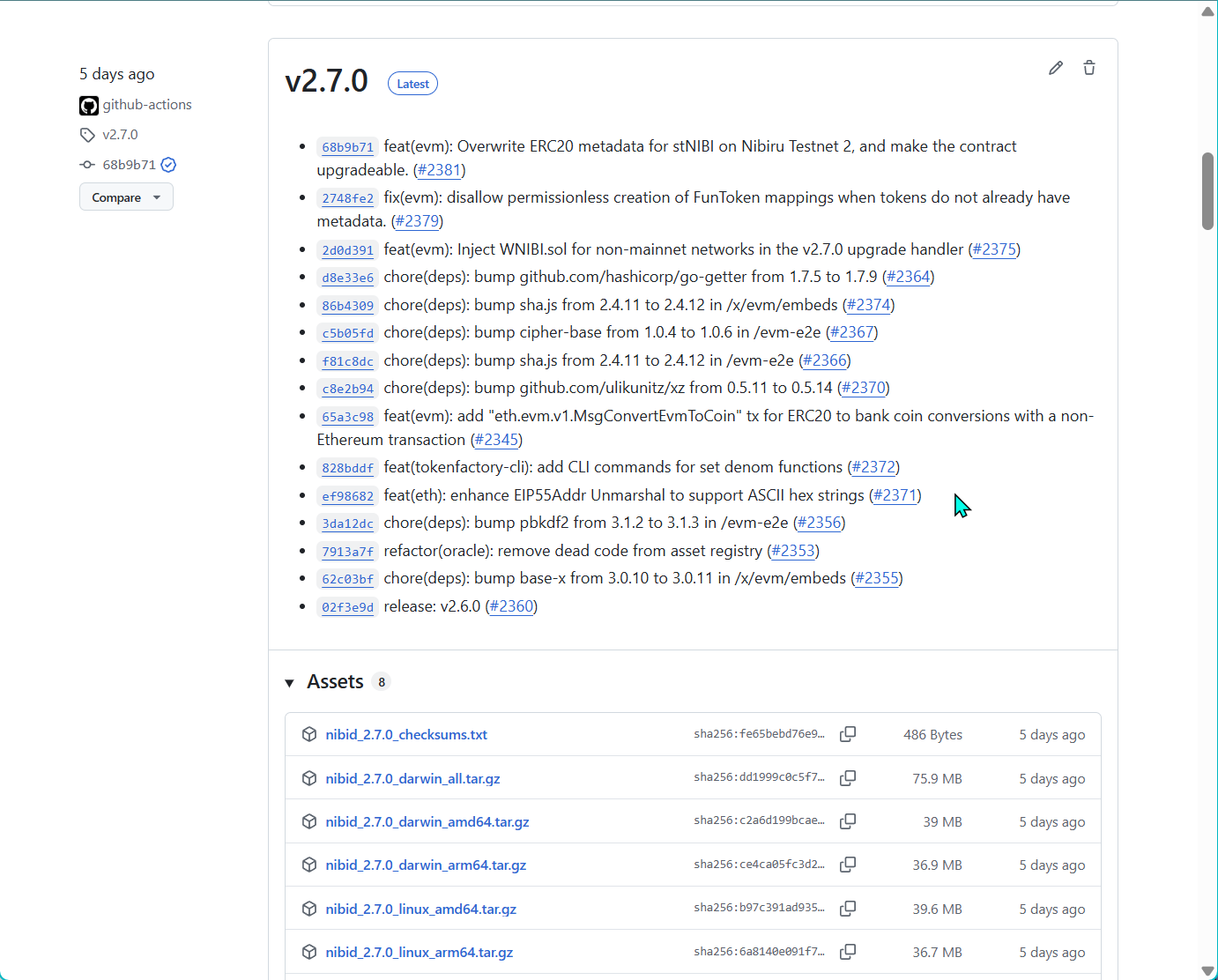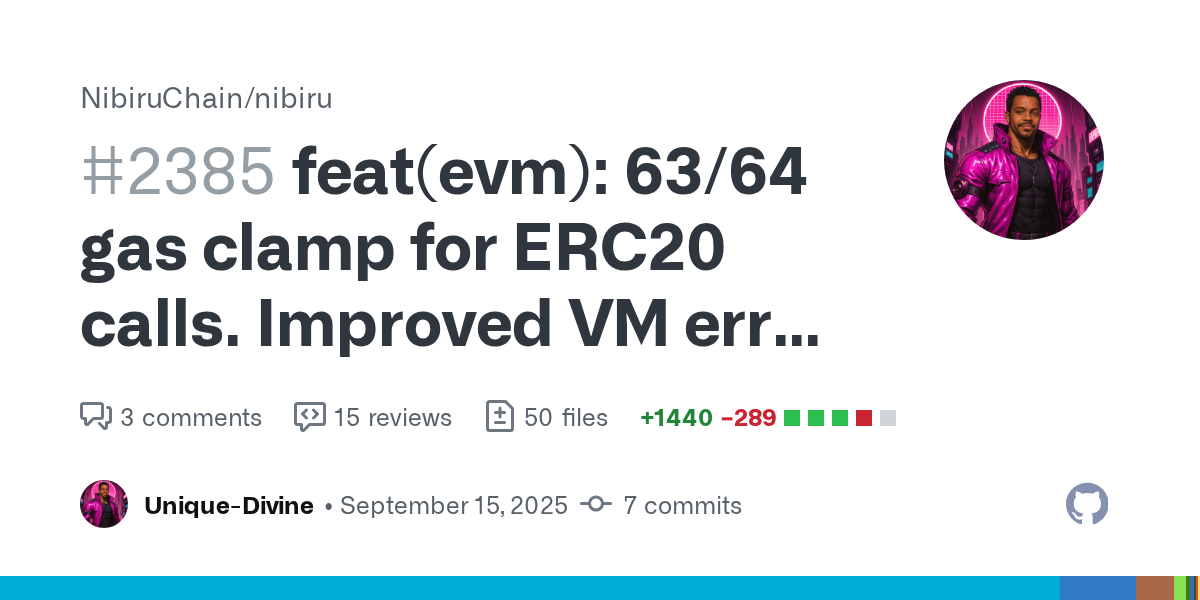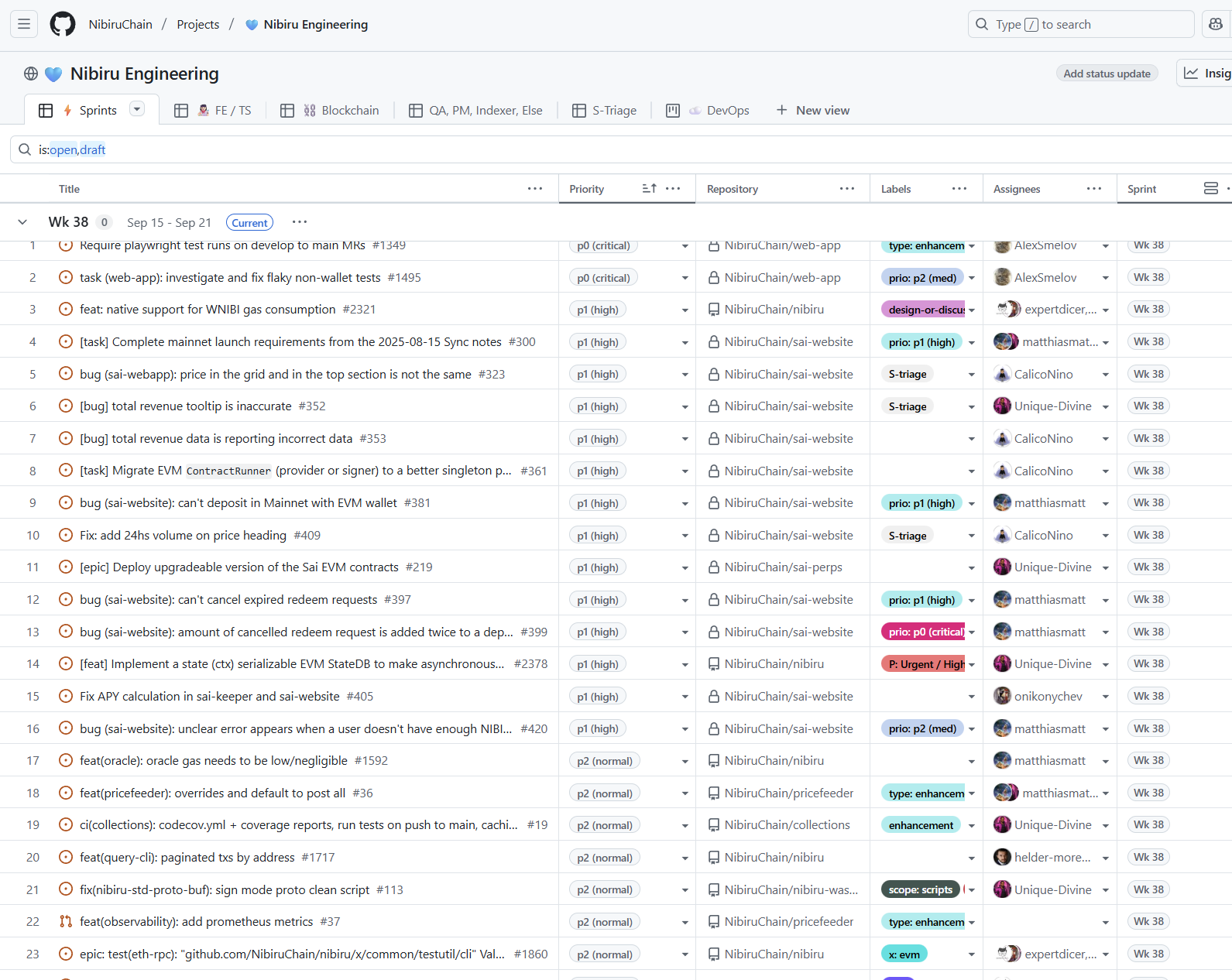NAN 001: Genesis of NANs, Nibiru v2.7.0, and BTC on Nibiru
Posted by Unique on 2025-09-19
Update #3 - May 2025 < Nibiru Advancement Notes (NANs) > NAN 002
The team at Nibiru has been building nonstop for a few years now, since well before the project left stealth. That's great that we've been active. But in my opinion, we've done a poor job of providing updates about our progress to keep everyone in the loop.
This post marks the "genesis" of Nibiru Advancement Notes (NANs), a recurring series meant to fix that gap. NANs are not marketing updates or improvement proposals. They're working notes that capture the context, decisions, tradeoffs, lessons, and nuance that comprises internal discusssions and meeting minutes but gets entirely lost in public-facing communication.
My goal here is simple. More transparency, clearer insight into process, and the creation of a living, semi-structured history of how and why Nibiru evolves over time.
Nibiru v2.7.0 Upgrade
The Nibiru v2.7.0 upgrade passed as its on-chain proposal and went live on Thursday, Sep 18, 2025. Everything went smoothly.
This upgrade was bigger than most, particularly because it gets executed differently depending on which network it's applied to. The upgrade does one thing for a local instance of the Nibiru node software and a different thing on testnet or on mainnet.

Highlights
The upgrade brought in two main features. The first new feature was changing the logic for cross-VM fungible tokens to handle WNIBI automatically.
In any Bank ⇄ EVM conversions that happen outside of an EVM precompile, NIBI ⇄ WNIBI is handled like other fungible token mappings. And, nodes that run the Nibiru software on testnets or other networks come with WNIBI.sol preloaded at the same contract address it would normally have on mainnet. This is good because it makes the chain easier to test, and rigorous testing is the primary defense anyone has against hacks.
The second new feature we added was a new transaction type that enables certain non-EVM accounts to send and manage ERC20 tokens that may be sent to them. When I say "Non-EVM accounts", I mean Wasm contracts and accounts with public key type "cosmos.crypto.secp256k1.PubKey" created with Keplr, Leap, or general IBC interactions.
Sai, a trading app building on top of Nibiru, is implemented in Rust contracts that compile to Wasm with a Solidity wrapper and full EVM support. This new transaction was the last piece of the puzzle in bringing Sai's first version to mainnet. Well, that and making sure the app works properly. The dev team is continuing to grind on that to see that the app can be brought to during the Block Party Season 2 campaign.
Bug Squashing
Working on these two changes for v2.7.0, we also discovered and resolved other bugs that have pained app developers in tandem.
One bug related to "out of gas" errors that erased other information from Ethereum transactions on Nibiru. And another bug where creating fungible token mappings on Nibiru was highly error-prone because the transaction was not defensive.
A user could create some token in either virtual machine (VM), an ERC20 token or a Bank Coin, and forget to give it a "name" or "symbol" metadata or forget to set non-zero decimals. Then creating the fungible token counterpart in the other VM would result in a newly created token with missing metadata.
All of this has been resolved and cleaned up.
Impact on Users/Builders & Next Steps
Developers can expect smoother cross-VM behavior and less friction when deploying apps. While no immediate patch is needed, the roadmap toward v2.8 and v3 already includes further improvements for mainnet and developer experience.
Bitcoin Bridging: Coinbase Wrapped BTC (cbBTC) on Nibiru
Our team finished the hard part: convincing teams of builders and miners to migrate BTC liquidity over to Nibiru. The only problem was that we didn't have a simple and trustworthy onboarding path for BTC to make its way to Nibiru.
First Attempt: WBTC. Initially, we thought WBTC would be a shoe in since it's already got a LayerZero OFT that could be connected to us. But it's not permissionless. It turned out there was huge paywall standing in the way of us bringing this form of BTC and BTC yields to Nibiru.
Back to the drawing board. Although less well known, there are several competitors to WBTC as wrapped Bitcoin alternatives that would still give Nibirun end users the onboarding experience we're looking for.
Second Attempt: tBTC. The token tBTC would've been great to use, but that required a new Wormhole integration, or it would force people to have to bridge twice. Once to a "neighboring" blockchain that has native token issuance via Womhole, and then again to get to or from Nibiru. Not really an option for us.
Third Attempt: BTC.b. At this point, we were growing disillusioned with permissioned apps being marketed as permissionless. Some of our team members came to Nibiru from Avalanche, so we then got in touch with Ava Labs about using BTC.b, one of the larger wrapped Bitcoin tokens coming from the Bitcoin blockchain over to Avalanche for its peg.
BTC.b had what we needed, an OFT contract under the management of a team that supports new integrations, and noteworthy usage and liquidity up into the tens of millions. We came to find out that BTC.b is largely abandoned in terms of its aptitude for integrations with new chains. Or maybe abandoned is too extreme. "Dormant" would be more accurate.
Final Path: cbBTC. We finally iterated our way to Coinbase Wrapped BTC (cbBTC) from this continued effort. It had traction, was paired against the right assets on exchanges, and had a clear pathway for us to launch OFTs for cbBTC without being blocked by the slowness of other teams. This was the pragmatic choice, and it worked.
So cbBTC became Bitcoin on Nibiru.
We set up bridging for the new token both on Stargate and in the Nibiru web app. And there's some starter liquidity for cbBTC:stNIBI and uBTC:cbBTC on Oku on Nibiru.
Nibiru documentation improvements
Clear docs are important just like clear code. As of late, we focused on making Nibiru's documentation faster, easier to navigate, and more complete.
- Layout: Reorganized with a more intuitive structure.
- Themes: Now supports both light and dark mode.
- Performance: Shortened page load times cut significantly.
We also fixed a common pain point with oracle feeds. I noticed that builders on Nibiru often have trouble finding the oracle feed information, more so for the EVM in particular. We've updated the content there so that, even if someone ends up on the wrong page, they can still easily find information on the ChainLink-like contracts that many apps will rely upon.
We've helped set up several omnichain fungible tokens (OFTs) powered by LayerZero on Nibiru too. And I think those have a similar problem as the oracle contracts, where it's hard to find reference info. We're working to add detailed, actionable documentation for all of the key tokens working their way into the Nibiru ecosystem.
Composite Oracle Feeds
One gap we saw with oracle feeds was that a single pair often isn't enough. For example, you might want yieldBTC/USD, but the raw feeds available are yieldBTC/BTC and BTC/USD. Builders were either stitching those together off-chain or relying on external middleware, which creates friction and extra trust assumptions.
To solve this, we rolled out composite oracle feeds. These let multiple oracle pairs be combined into a single Chainlink-style feed that's ready to use on-chain. It keeps things standardized and familiar for developers who already know how to integrate Chainlink data feeds, while pushing more of the heavy lifting into the protocol itself.

Composite feeds are already live in production and serving real price data. That means apps can plug into them directly without custom logic, and integrations get simpler, safer, and more consistent. This is part of a broader effort to reduce rough edges for builders and make Nibiru's oracle system more flexible as new assets come online.
More on the Sai Perps App
We tend to work in one-week sprints. And the past few weeks have been a huge push for the team to get Sai in working order for a mainnet release with the launch of Nibiru Block Party season 2.
But with several developers working on overlapping code at rapid speeds, we encountered some challenges where we didn't have the Sai app in a working state on the upstream, dev branch. That made it hard to do quality assurance.

So our frontend and QA devs worked on solid per-merge QA and proposed what I'll call a "surgeon's checklist" for us to help prevent regressions. It's a lightweight process not yet automated for lack of time, but it's helping make the app more stable as development continues.
Although I'm not yet happy with the state of the app, I do commend the work output of the devs working on Sai, covering everything from a novel Multi-VM indexer, surfacing of new and crucial improvements for Nibiru, database and API construction, and pumping out frontend changes with fewer than 5 folks working on it.
Closing Thoughts
That's it for now. More to come soon.